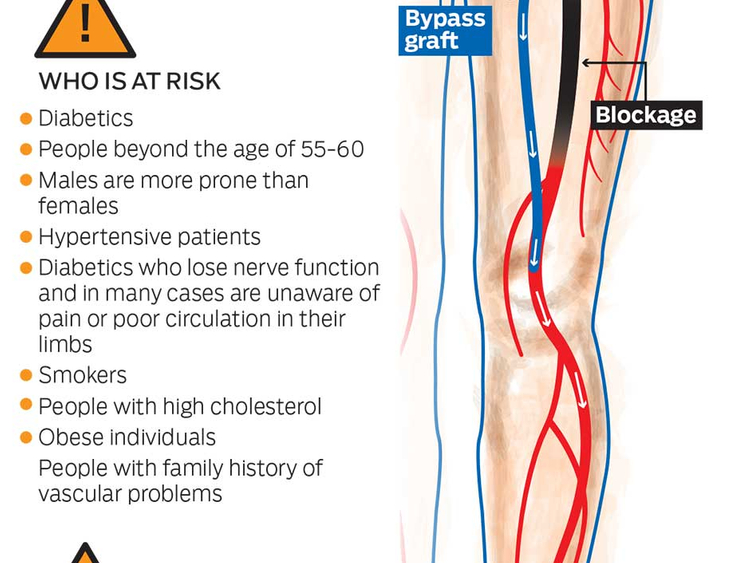Dubai: Peripheral Vascular Disease (PVD) is on the rise in the UAE, according to an internationally published study conducted in the Arabian Gulf that included Kuwait, UAE and Qatar.
In the UAE, the study covered people above the age of 18 across 64 health centres and found the prevalence to be in 13.5 per cent of the population.
What is PVD and why should you care about it? Peripheral Vascular disease results in poor blood circulation in arteries and veins and this condition needs to be understand in its proper context. The word vascular refers to the network of blood vessels in our body that transports blood and both arteries and veins perform this function. Impairment in their condition can be a serious problem for the patient.
While blocked arteries in the heart are the most commonly understood phenomenon, the truth is arteries anywhere in our body can get blocked by build-up of plaque. Arteries carry oxygenated blood to the organs from the heart and when that blood flow is interrupted, it can lead to poor circulation. This, in turn, leads to a possibility of abdominal aneurysms (excessive localised swelling in the wall of artery) that have a high risk of haemorrhage, carotid artery blockage which can be fatal as they can cause stroke and Peripheral Artery disease (PAD), that blocks the main arteries that transport oxygenated blood to the legs.
Poor blood flow in the veins causes varicose veins and Deep Vein Thrombosis (DVT).
In extreme cases, poor blood circulation to the extremities can lead to gangrene and limb amputation.
In the UAE, which has a high rate of diabetes, obesity and a sizable smoking population, PAD is a cause of worry.
Dr Amit Kumar, endovascular surgeon at BR Suites, Dubai, who has been working to save gangerenous limbs of many patients in the UAE said, “PAD is on the rise [in the UAE}. I have seen a steady rise in patients with this condition. Every month, I have at least five to six cases of severe PAD where minimally invasive surgery is required to save the patient’s limb. But I want to assure people that early intervention makes PAD treatable. A simple test can determine [if you have the condition].”
Explaining the etymology of the disease, Dr Kumar said, “Our arteries deliver oxygen-rich blood from our heart to other parts of the body and the peripheral arteries carry blood away from the heart to the arms and legs. The peripheral arteries in the legs are extensions of the largest artery in our body called the aorta. When arteries are healthy, the oxygenated flow of blood is unobstructed.
“PAD occurs when arteriosclerosis, or hardening of arteries that carry blood to the legs, occurs due to a build-up of plaque in these blood vessels. The blockage results in reduced flow of blood and oxygen to the extremities and, with time, the toe or foot begins to swell, turn black and without timely intervention, might need amputation to save the rest of the limb.”
A simple test can check your circulation level, and in case of poor circulation, an angioplasty in most cases can restore blood supply and save the limb, he said. “This is a mininally invasive surgery and I have been able to prevent many amputations with timely intervention,” said Dr Kumar.
Who is at risk?
1. Diabetics
2. People beyond the age of 55-60
3. Males are more prone than females
4. Hypertensive patients
5. Diabetics who lose nerve function and in many cases are unaware of pain or poor circulation in their limbs
6. Smokers
7. People with high cholesterol
8. Obese individuals
9. People with family history of vascular problems
Symptoms:
1. Pain in the legs
2. Difficulty in walking
3. Resting pain in the foot at night
4. Non-healing sores or infections in foot and toes
Diagnosis and treatment
A simple non-invasive Doppler test in a vascular laboratory at a hospital can help measure the transcutaneous oxygen levels in the limbs, ankles and toes. Dr Kumar, one of the few endovascular surgeons conducting this test, said: “Treatment varies from medical management of the condition that includes medication and lifestyle changes with healthy diet and moderate exercise to minimal invasive surgeries such as angioplasty, stenting and even open bypass surgery. If a patient had 30 per cent blood flow prior to angioplasty, he or she will have 100 per cent flow after the surgery. I have treated at least 10 cases on an average in a month where surgery has helped avoid amputation. I request GPs to detect cases of PAD and alert their patients to seek help,” he cautioned.
Case study
Bob (not his real name), 60, based in Oman, with a history of 10 years of diabetes and smoking, almost lost his right foot to amputation. Initially, he had no symptoms of PAD. “My job required me to be posted in remote locations and poor diet and lack of exercise exacerbated my condition. It began with a deep foot pain and visits to a hospital did not provide me with any relief. Finally, after a couple of months, I was unable to walk and my toe nail turned red and inflamed. [I visited] Dr Kumar [who] conducted the test that determined that gangrene had set in. He put me on antibiotics to arrest the infection, conducted an angioplasty that restored circulation in my limbs. Had I delayed seeing him by even a week, I would have had to get either my toes or right limb amputated. I am still on antibiotics and the doctor has assured he will save me from any kind of amputation,” said Bob, who is as of now still having to use a wheelchair.













